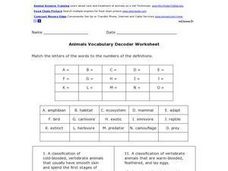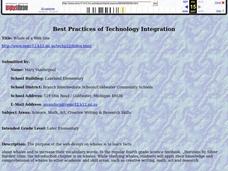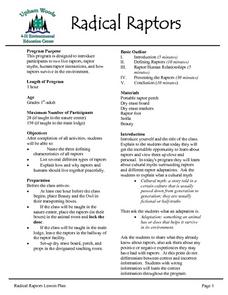Curated OER
Introduction to Wetlands
Students describe the characteristics of a wetland, identify plants and animals found there, and how those plants and animals have adapted to their environment. They visit stations, view a video, and complete a KWL about the wetlands.
Curated OER
Whale Blubber
Students examine the purpose and characteristics of whale blubber. They work together to complete an experiment to test the fat as an insulator. They discover how humans use materials to protect them from the cold.
Curated OER
The Five Classes of Vertebrates
In this vertebrates classification worksheet, 5th graders unscramble 15 words to find answers to clues. Each clue gives information about the characteristics of vertebrates.
Curated OER
Get to Know Trees
Young scholars recognize the characteristics of trees by using their five senses. In this trees instructional activity, students observe and record the characteristics of trees on a field trip. Young scholars then are blindfolded and...
Curated OER
Investigation: Reasoning and Proof
Students explore animal characteristics by creating illustrations. In this animal identification lesson, students read a list of animal descriptions which they draw using crayons or colored pencils. Students view their drawings and...
Curated OER
Kids for Conservation: Animal Unit
Students discuss animal needs and characteristics. In this animal mini-unit, students complete three activities studying different animals, their needs, how they have evolved, and how to protect them.
Curated OER
Kingdom Animalia ~ A Look at the Five Major Classes
Biological taxonomy masters examine the five main classes under phylum chordata. Pupils compare and contrast the identifying characteristics of the various organisms. They explain why taxonomy is important in classifying organisms. You...
Curated OER
Animals Vocabulary Decoder Worksheet
Add some decoding to your scholar's review of basic life science terms in this decorder activity, where students match 15 words to their definitions. Words such as mammal and amphibian must be matched to their written definition. The...
Curated OER
Fact or Opinion: Animals
How many legs do spiders have? Is that an opinion, or is it a fact? Complete a worksheet with four sets of five questions about different animals and their attributes, noting whether each statement is a fact or an opinion.
Curated OER
Bats - Endangered Mammal
Students complete question sheet on Bats and research information using a list of websites provided by the teacher. They work with peers to complete a scavenger hunt worksheet about bats.
Curated OER
Interview a Professional: Marine Mammal Rescue
Students choose a career featured on the school to career website. They research the career and email an expert in the field of their choice. They answer a series of questions and write a written report on their findings and present...
Curated OER
Understanding How Researchers Study Dolphins
Students examine how researchers study dolphins and whales. In this scientific research lesson, students complete a Web-based interactive lesson focused on showing how researchers study aquatic mammals. A worksheet and web resources are...
Curated OER
African Savanna
First graders are introduced to the ecosystems of savannas throughout the world. Using new vocabulary, they identify and describe the characteristics of a savanna and the animals that live there. They also describe the Earth's physical...
Curated OER
Out of the Deep
Learners observe, describe, and record characteristics of ocean animals (mammals and fish) and sea shells. They conduct an experiment comparing and contrasting sugar water, salt water and fresh water and create a mural of coral reef...
Curated OER
Whale of a Web Site
Students compare and contrast differences and likeness of whales/fish and toothed/baleen whales and discuss what they know about whales and what they would like to study about whales. They then describe the characteristics of a mammal.
Curated OER
Radical Raptors
Students are introduced to raptors and their role in the environment. They identify three characteristics of raptors and list several types of raptors found in nature. They discuss their positive and negative experiences with raptors and...
Curated OER
VERTEBRATES
Seventh graders describe the main characteristics of warm-blooded vertebrate animals. They compare and contrast the two different groups of warm-blooded vertebrate animals by looking at external, reproductive, and growth characteristics.
Curated OER
Birth, Growth and... Reproduction!
Students research the Arctic Hare and chart relevant information under month headings. They compare the information about the Arctic hare to other Arctic mammals.
Curated OER
Verterbrate Classification
Students are introduced to the broad categories of vertebrates including fish, amphibians, reptiles, birds and mammals. They identify the characteristics of each group and then view slideshows and video of example species.
Curated OER
Learning about Snakes- Non-Fiction Reading Comprehension Worksheet
In this snakes non-fiction reading comprehension activity, 3rd graders read a one page selection about the characteristics of snakes. They complete a table which compares snakes to mammals, and fill in the blanks in 5 questions using...
Curated OER
Classy
Students explore the classification system in this seven lessons unit. The diversity of life forms and their characteristics are examined using a microscope. Kingdoms, classes, and families are investigated.
Curated OER
Vertebrates
Fifth graders examine the traits and characteristics of vertebrates. Identifying the key factors that make the classes of vertebrates unique, they create a children's book. They decide which material is necessary to share about the...
Curated OER
Animal Classification
Students recognize the six groups of animals (Mammals, fish, birds, reptiles, amphibians and arthropods) and their characteristics. In this animal characteristics lesson, students sort animals by their traits. Students cut and paste...
Curated OER
Explore the Arctic: A Scavenger Hunt
Learners explore the Arctic region using the internet. They identify characteristics of animals that live in the Arctic and locate the Arctic region using a map of the United States.









